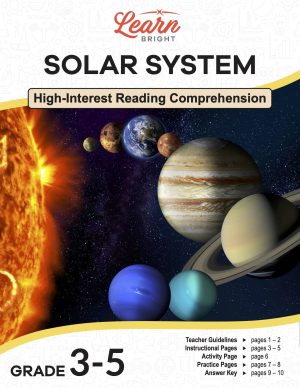Description
What our Metric Measurement lesson plan includes
Lesson Objectives and Overview: Metric Measurement strengthens student understanding of the metric system. At the end of the lesson, students will be able to define metric measurement, identify the metric units used in weight, length, and volume, and convert from smaller/larger to larger/smaller units. This lesson is for students in 4th grade, 5th grade, and 6th grade.
Classroom Procedure
Every lesson plan provides you with a classroom procedure page that outlines a step-by-step guide to follow. You do not have to follow the guide exactly. The guide helps you organize the lesson and details when to hand out worksheets. It also lists information in the blue box that you might find useful. You will find the lesson objectives, state standards, and number of class sessions the lesson should take to complete in this area. In addition, it describes the supplies you will need as well as what and how you need to prepare beforehand.
Options for Lesson
Included with this lesson is an “Options for Lesson” section that lists a number of suggestions for activities to add to the lesson or substitutions for the ones already in the lesson. One optional addition to this lesson is to have your students use metric measuring containers to measure liquids. You can also have them measure metric weight using a scale. Finally, you could have your students measure longer lengths using the metric system and meter sticks if available, such as size of your classroom, hallway length, or outdoor areas.
Teacher Notes
The teacher notes page includes a paragraph with additional guidelines and things to think about as you begin to plan your lesson. This page also includes lines that you can use to add your own notes as you’re preparing for this lesson.
METRIC MEASUREMENT LESSON PLAN CONTENT PAGES
Using the Metric System
The Metric Measurement lesson plan includes two content pages. Most of the world uses the metric measurement system, but the United States does not. The metric system is a decimal system of measurement based on meters, liters, and grams. It uses meters instead of feet, grams instead of pounds, and liters instead of gallons. The metric system is actually easier to use than the U.S. standard system once you learn how to use it!
The metric system is based on the number 10. Therefore, in order to change large units to small units you multiply by 10, 100, or 1000. To change small units to large units you divide by 10, 100, or 1000.
On the other hand, in the standard (also called imperial) system that the U.S. uses, changing small and large units requires multiplication and division by a variety of numbers, like 3, 4, 8, 12, or 16.
The metric system uses three basic or base units of measurement: meters for length, grams for weight, and liters for volume or liquid capacity. You only need to learn three main prefixes for these units. From smallest to largest, these prefixes are milli-, centi-, and kilo-. There are also other prefixes which it uses less often: deci-, deka-, and hecto-.
Instead of inches or feet, you use centimeters or meters; instead of ounces and pounds, you use milligrams or grams; and instead of cups and gallons, you use deciliters or liters. Make sure to take note of the prefixes added to each of the base units. To show that the length, weight, or volume of an object has changed, you simply use a different prefix.
Metric Conversion
The lesson includes a helpful metric conversion chart that you can easily reference. Using 1 meter, gram, or liter as the base, it lists each prefix and its corresponding value. Kilo- is 1000, hecto- is 100, deca- is 10, deci- is 1/10, centi- is 1/100, and milli- is 1/1000. This means that a kilometer is 1,000 times larger than the value a meter, while a millimeter is 1/1000 of a meter.
Remember that when converting from large to small units, you multiply, and when converting from small to large units, you divide.
Examples for Metric System
The lesson includes a few real-world examples with conversions between metric units.
Humpback whales weighs about 36,000 kilograms (80,000 pounds) and can measure up to 16 meters (about 52 feet) long. If we wanted to change kilograms to grams, we multiply since we’re changing from a larger unit to a smaller unit. We multiply by 1,000, since it is two steps away: 36,000 x 1000 = 36,000,000 grams. To convert its length, 16 meters, to decameters, we divide by 10 since it’s only one step away: 16 ÷ 10 = 1.6 decameters.
Most round swimming pools hold about 56,000 liters (15,000 gallons) of water. Say we wanted to convert that to kiloliters. We’re going from a smaller unit to a larger unit, so we divide. It’s two steps away, so we divide by 1000: 56,000 ÷ 1000 = 56 kiloliters.
It requires a small amount of ingredients to bake a batch of brownies. For example, we only need 5 milliliters (about 1 teaspoon) of vanilla extract. To change that to liters, we go from a smaller unit to a larger unit, so we need to divide. It’s two steps away, so we divide by 1000: 5 ÷ 1000 = 0.005 liters.
When we convert between different units of measurement, we simply multiply or divide by 10, 100, or 1000. Remember that milli- is the very smallest unit. We might use it to measure the length or weight of an insect (in millimeters or milligrams), or the amount of medicine in a dropper (in milliliters). The largest is kilo-, which we might use to measure the volume or length of a river (in kiloliters or kilometers). Finally, instead of weighing yourself in pounds, we can use grams; for height, we can use meters; and for the amount of water you drink each day, we can use liters.
Abbreviations of Common Metric System Units
The lesson closes with a helpful chart that lists some examples of metric system measurements and abbreviations of those units.
The abbreviation for kilometers is km; for meters is m; for centimeters is cm; and for millimeters is mm. Next, the abbreviation for kilograms is kg; for grams is g; and for milligrams is mg. Finally, the abbreviation for kiloliters is kl; for liters is l; and for milliliters is ml.
Now that we know the abbreviations, let’s look at some examples. First, the length of a football field is 91.4 m or 9,144 cm. Next, the volume of ink inside a pen is 0.27 ml or 0.00027 l. The volume of water in a bathtub is 265 l or 0.265 kl. Finally, the weight of the Statue of Liberty is 204,117 kg or 244,117,000 g.
METRIC MEASUREMENT LESSON PLAN WORKSHEETS
The Metric Measurement lesson plan includes three worksheets: an activity worksheet, a practice worksheet, and a homework assignment. You can refer to the guide on the classroom procedure page to determine when to hand out each worksheet.
MEASURING LINES ACTIVITY WORKSHEET
For the activity worksheet, students will first measure each line using the given unit of measure. They will then look at 15 different packages (of food, items, etc.) and convert each package’s metric volume or weight to smaller and larger units.
CONVERSION PRACTICE WORKSHEET
The practice worksheet asks students to first convert each of the listed metric measurements into the given units. They will then solve three word problems.
METRIC MEASUREMENT HOMEWORK ASSIGNMENT
For the homework assignment, students will first write the abbreviation of each of the given units of measure. They will also answer ten questions about the lesson material.
Worksheet Answer Keys
This lesson plan includes answer keys for the activity worksheet, the practice worksheet, and the homework assignment. If you choose to administer the lesson pages to your students via PDF, you will need to save a new file that omits these pages. Otherwise, you can simply print out the applicable pages and keep these as reference for yourself when grading assignments.









